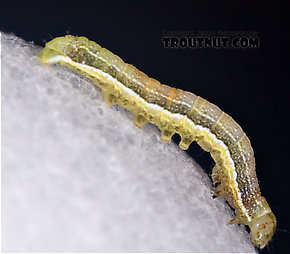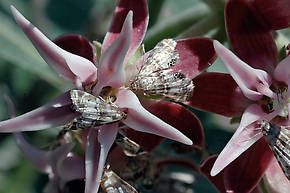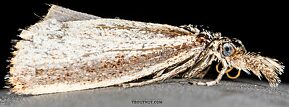Blog & Latest Updates
Fly Fishing Articles
Insects by Common Name


Insect Order Lepidoptera (Moths)
Taxonomic Navigation -?-
Kingdom
Animalia (Animals)
» Phylum
Arthropoda (Arthropods)
» Class
Insecta (Insects)
» Order Lepidoptera (Moths)
| Family in Lepidoptera | ||
| GeometridaeInchworms | 0 | 0 |
12 families aren't included.
Common Name
| Match | Common Name |
| Moths |
Many species, of course, are not aquatic at all.
Hatching Behavior
The pupae of aquatic moths turn into adults underwater in their cocoons, so they are not worth imitating. The emerging adults, swim away from their pupal cocoons and are vulnerable to trout until they crawl or fly away from the water.
Egg-Laying Behavior
Time Of Day: Usually dusk or nighttime
Mirroring the behavior of caddisflies, aquatic moths may lay their eggs on the surface or dive underwater to lay them on the bottom. The diving species are the most common, and they are especially vulnerable to trout. Anglers frequently see the adults in our flashlights as we leave the stream for the night, and Swisher and Richards wrote in Selective Trout:Because almost all of the action is at dusk and later, anglers don't realize how prolific these insects really are.
Larva & Pupa Biology
Diet: Algae and plankton
Shelter Type: Some build silk shelters.
Aquatic moth larvae live in a variety of ways underwater, including building silken shelters. Their appearances vary tremendously in size, color, and form, but they are a rare find in most places. In all my nymph sampling I have never yet turned up an aquatic moth larva.Shelter Type: Some build silk shelters.
Pictures of 4 Moth Specimens:
Geometridae (Inchworms) Moth Larva View 6 PicturesI caught this inchworm lowering itself to the surface of a trout stream from its silk thread. I saw a couple others floating on the surface, so it's likely the trout were familiar with them.
View 6 PicturesI caught this inchworm lowering itself to the surface of a trout stream from its silk thread. I saw a couple others floating on the surface, so it's likely the trout were familiar with them.
 View 6 PicturesI caught this inchworm lowering itself to the surface of a trout stream from its silk thread. I saw a couple others floating on the surface, so it's likely the trout were familiar with them.
View 6 PicturesI caught this inchworm lowering itself to the surface of a trout stream from its silk thread. I saw a couple others floating on the surface, so it's likely the trout were familiar with them.Collected May 29, 2007 from Brodhead Creek in Pennsylvania
Added to Troutnut.com by Troutnut on June 4, 2007
Added to Troutnut.com by Troutnut on June 4, 2007
Lepidoptera (Moths) Moth Adult View 2 PicturesI have been told this is the only western aquatic moth, Petrophila confusalis, see here on milkweed blossoms.
View 2 PicturesI have been told this is the only western aquatic moth, Petrophila confusalis, see here on milkweed blossoms.
 View 2 PicturesI have been told this is the only western aquatic moth, Petrophila confusalis, see here on milkweed blossoms.
View 2 PicturesI have been told this is the only western aquatic moth, Petrophila confusalis, see here on milkweed blossoms.Collected July 21, 2005 from the Flathead River-lower in Montana
Added to Troutnut.com by Bnewell on June 28, 2011
Added to Troutnut.com by Bnewell on June 28, 2011
Lepidoptera (Moths) Moth Adult View 8 PicturesIn the field, I accidentally mistook this moth for a weird-looking caddisfly. Only later did I notice the moth mouthparts and that the "hair" on the wings is actually tiny, flat scales.
View 8 PicturesIn the field, I accidentally mistook this moth for a weird-looking caddisfly. Only later did I notice the moth mouthparts and that the "hair" on the wings is actually tiny, flat scales.
 View 8 PicturesIn the field, I accidentally mistook this moth for a weird-looking caddisfly. Only later did I notice the moth mouthparts and that the "hair" on the wings is actually tiny, flat scales.
View 8 PicturesIn the field, I accidentally mistook this moth for a weird-looking caddisfly. Only later did I notice the moth mouthparts and that the "hair" on the wings is actually tiny, flat scales.Collected July 31, 2020 from the Henry's Fork of the Snake River in Idaho
Added to Troutnut.com by Troutnut on August 17, 2020
Added to Troutnut.com by Troutnut on August 17, 2020
Your Thoughts On Lepidoptera:
Top 10 Fly Hatches
Top Gift Shop Designs
Eat mayflies.
Top Insect Specimens
Miscellaneous Sites
Troutnut.com is copyright © 2004-2024 Jason
Neuswanger (email Jason). See my FAQ for information about use of my images.
 privacy policy
privacy policy
